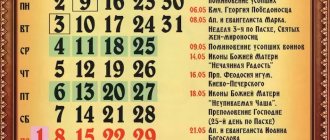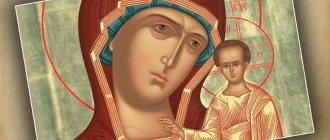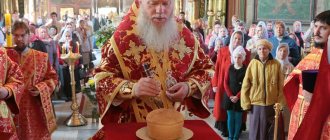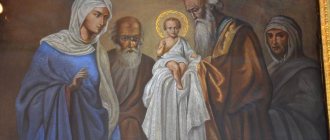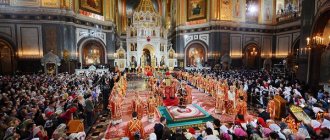An Orthodox holiday is a special day in the life of every Orthodox person. On this day, especially revered saints are remembered, and believing families dedicate this day to celebration.
For clarity and convenience, the Orthodox Church unofficially introduced the concept of Orthodox church calendars. What are they? In church calendars, Orthodox holidays, fasts and accompanying services are consistently indicated for each month. Thus, thanks to this system of recording holidays, the Orthodox Church organizes all existing Orthodox holidays. The term church calendar is broader than one might think. Also, church calendars refer to various printed publications that include elements of the monthly calendar that relate to each year. This includes other liturgical and menological materials. A detailed church calendar for October 2022 is also available on the i-sonnik.ru portal.
Let's talk in more detail about the revered Orthodox holidays of October.
Other holidays
Orthodox Christians celebrate other important dates this month:
- The 3rd is the day of St. Abramius, the miracle worker of Smolensk (XIII), on this day tribute is paid to the memory of this saint, a service is held in the temple;
- The 8th is the day of the Vladimir Icon of the Mother of God in honor of the salvation of Moscow from the invasion of enemies in the 14th century;
- 19th - Miracle of the Archangel Michael, the day of the first frost, when the Archangel Michael saved Orthodox Christians from disaster by miraculously creating a passage in the rock;
- The 22nd is the day of the Righteous Godfather Joachim and Anna. St. Joseph, abbot of Volotsk, wonderworker;
- The 30th is the Day of the Holy Martyrs Faith, Nadezhda, Lyubov and their mother Sophia, who died for their faith.
All these events are of great religious significance for believers, although they do not belong to the Twelfth Holidays.
History of the Feast of the Intercession of the Virgin Mary
According to church tradition, in 910 the Mother of God saved Constantinople and its inhabitants from plunder by barbarians. When the city was under siege, people gathered and prayed in the Blachernae Church, says Thomas. The Mother of God appeared to those praying and spread her omophorion (head cover) over the people.
This miracle became a sign of intercession and consolation.
Prince Andrei Bogolyubsky established the holiday of the Intercession of the Virgin Mary in Rus' in the middle of the 12th century, RIA Novosti clarifies. However, it is not known whether it was celebrated earlier, whether this day was a holiday back in Byzantium, or whether it is an exclusively Russian holiday.
• The sanctified time of the Church: the church new year and the peace circle. This day is marked on the calendar as the beginning of the indictment. Christians did not want to share the beginning of the new year on the same day with the followers of Confucius, Allah, and Buddha, so they decided to consider September 14 (September 1, old style) to be the beginning of the Orthodox new year. The holiday of the Church New Year was established by the holy fathers of the First Ecumenical Council, who determined that the calculation of the church year should begin on September 1/14. The first day of the annual liturgical circle marks the “entrance of summer,” and the service of this day is of a festive nature, the culmination of which is the Gospel read during the liturgy, which tells about the beginning of the preaching of Jesus Christ after His Baptism and temptations from the devil in the desert. According to legend, this happened on the first day of the Jewish harvest festival, which was celebrated from September 1 to 8. In the Gospel we hear the Savior preaching to us the onset of the favorable “summer of the Lord.” On this day, Jesus Christ began preaching the Kingdom of God and for the first time witnessed the fulfillment of Old Testament prophecies about the coming of the Messiah (Son of God) and thereby the end of the Old and the beginning of the New Testament. • Righteous Joshua (XVI century BC). • Martyrs Callistas and the brothers of her martyrs Evoda and Hermogenes. • Martyr Aifala deacon. • The martyrs of the 40 fasting virgins and the martyr Ammun the deacon, their teacher. • Reverend Simeon Stylite and his mother Martha. Simeon the Stylite (5th century) became famous as a man of a selfless lifestyle. He discovered a new type of asceticism. Wanting to test his spiritual strength and faith in God, he built a 4-meter-high pillar on the mountain with a platform on top, surrounded it with a wall, and from this “mountainous” place read sermons to numerous pilgrims. Then Simeon settled on a pillar in a small cell, devoting himself to intense prayer and fasting. Gradually he increased the height of the pillar on which he stood. Its last pillar was 40 cubits (16 meters) high. He spent 80 years in intense monastic labors, of which 47 stood on the pillar. His life was well known in Rus'; people learned from him to endure numerous difficulties of human existence in the name of a holy cause. According to an ancient tradition, it was believed that on this day it was necessary to perform charitable deeds and be merciful. In Muscovite Rus', not a single beggar was left without abundant alms on this day, and even prisoners in prison were given gifts. .Day of Semyon the Flyer (Semyon, Simeon the Stylite, Semyon the summer guide, summer guide, farewell to summer, Semyon day, Semyon day, first autumn, Indian summer, meeting autumn, apiary day, onion day, sitting, end of summer, beginning of autumn, last sowing). The first meeting of autumn, the end of the young Indian summer and the beginning of the old one. Many beliefs and rituals were associated with this day in ancient times. And it’s not surprising, because in pre-Petrine Rus', September 1 was considered the beginning of the new year. In 1700, Peter I moved the New Year celebration from September 1 to January 1. Gradually, the holiday lost its former meaning, but many customs remained in the lives of the peasants. For example, in villages on September 14, cockroaches and flies were buried. They put it in a coffin carved from turnip or rutabaga and carried it with crying and lamentation to bury it as far as possible from home. Those who remained at home drove the flies out of the house, “fly after fly, fly to bury the flies.” This custom goes back to pagan times and is associated with the veneration of Belbog, the ruler of all insects. Another important custom was to extinguish the old fire and start a new one. The old men went out into the yard and rubbed two pieces of wood against each other until they began to smoke. The girl or daughter-in-law fanned the smoldering tree, and then lit a candle from the flaring fire. This fire was used to light the stove. The next morning the coals were fanned again. So the fire was kept in the stove all year. On this day, four-year-old boys were mounted on horses. This custom came from ancient times and was associated with the transition from infancy to adulthood. September 14 was called Indian summer in the villages because at this time various agricultural work began (crushing hemp, soaking flax, etc.), which was usually performed by women in the open air. With Semyon, the so-called sit-ins began, when they worked in the huts in the evenings. The first day of sitting was celebrated as a family holiday. All relatives met in the house of the eldest in the family. In the old days, time was allocated for wedding weeks from summer conductor (September 14) to Guria (November 28). From this day on, moles and mice move from fields to houses and gardens. Weather signs on September 14: If Marfa is dirty, autumn will be rainy. Indian summer (starts on September 14) is stormy - autumn is dry, and Indian summer is dry - autumn is wet. The drier and warmer September stays, the later winter will come. If the cones on the spruce tree have grown low, there will be early frosts, and if they are at the top, real cold will come only at the end of winter.Nativity of the Blessed Virgin Mary
This is one of the main events in the Orthodox calendar, which is celebrated on September 21 every year. It is believed that on this day Jokim and Anna had a daughter, Maria, who later became the Mother of God. It is with this event that the history of the New Testament begins. Tradition says that on this holiday, relatives visited the newlyweds, housewives baked round pies, and women went to the water with jelly and bread. On this day, childless women went to church services to ask the Mother of God to give them a child.
Other important events in October
The following dates of this month are also considered significant church events:
- The 8th is the day of St. Sergius of Radonezh, when the memory of this saint is honored and a special church service is held;
- The 9th is the day of the Apostle and Evangelist John the Theologian, who was one of the three disciples closest to Jesus, and was subjected to many persecutions after his departure;
- The 15th is the day of Blessed Andrew, Christ for the sake of the holy fool, who suffered a lot for the sake of his faith and witnessed the appearance of the Mother of God in the temple in Constantinople;
- The 18th is the day of Saints Peter, Alexy, Jonah, Philip, Hermogenes and Tikhon, wonderworkers of Moscow and all Russia, when services are held in memory of these events;
- The 19th is the day of the Apostle Thomas, who doubted Christ for a long time, but then believed and became his disciple;
- The 26th is the day of the Iveron Icon of the Mother of God, which is revered by Orthodox believers for the many miracles that happen to it;
- 30th - Memory of the holy fathers of the Seventh Ecumenical Council, who strengthened the Orthodox faith and condemned many heresies.
The exact dates on which these religious events are celebrated may vary depending on the calendar that is established annually.
Name days in October for women and men according to the church calendar
| date | For girls | For boys |
| 1.10 | Arina, Irina, Ariadna | Vladimir, Peter, Alexy, Sergey, Veniamin |
| 2.10 | Maria | Trofim, Konstantin, Georgy, Nikolay |
| 3.10 | Tatiana | Oleg, Ivan, Fedor, Illarion, Vasily |
| 4.10 | – | Boys' names: Joseph, Valentin, Jan, Daniil |
| 5.10 | Praskovya | Kuzma, Peter, Alexander, Nikolay |
| 6.10 | Raisa, Iraida | Peter, Ivan, Nikolay, Andrey |
| 7.10 | Thekla | Sergey, Vitaly, Pavel, Anton, Stepan |
| 8.10 | Euphrosyne | Maxim, Prokhor, Ostap, Nikolai |
| 9.10 | – | Tikhon, Afanasy, Ivan, Vladimir, Ian |
| 10.10 | Girls names : Fevronya, Akilina | Victor, Peter, Mark, Fedor |
| 11.10 | Ulyana, Anna, Yuliana, Maria | Kirill, Eremey, Valentin, Nestor |
| 12.10 | – | Jan and Ivan |
| 13.10 | Alexandra | Alexey, Leonid, Akakiy, Matvey |
| 14.10 | Faith | George, Peter, Gregory, Savva, Roman |
| 15.10 | Women's name days according to the calendar of names 2022, October 15: Anna, Alexandra, Ustinya | Stepan, David, Boris, Yakov |
| 16.10 | – | Pavel, Denis, Jan, Ivan |
| 17.10 | Veronica | Nikolay, Vladimir, Peter, Mikhail |
| 18.10 | Alexandra | Matvey, Gabriel, Makar, Demyan, Eremey |
| 19.10 | – | Jan, Makar |
| 20.10 | Pelagia | Leonty, Julian, Demyan |
| 21.10 | Girls born in October: Taisiya, Elizaveta, Tatyana | Seraphim, Victor, Dmitry |
| 22.10 | – | Yakov, Maxim, Stepan, Ibrahim |
| 23.10 | – | Simon, Anton, Efim, Thomas, Vasily |
| 24.10 | Zinaida | Makar, Alexander, Philip |
| 25.10 | Dominica | Bogdan, Taras, Martin, Ostap, Lavrentiy |
| 26.10 | Zlata | Veniamin, Trofim |
| 27.10 | Praskovya | Kuzma, Nazar, Ignat |
| 28.10 | – | Ian, Denis, Lukyan |
| 29.10 | – | Leonty, Dementy, Egor |
| 30.10 | – | Joseph, Andrey, Kuzma |
| 31.10 | Zlata, Elizaveta | Semyon, David, Theodor |
Saints in October
The names of which holy martyrs are remembered in Orthodoxy in October:
| date | Who is remembered |
| 1.10 | Theodulia, Hilarion, Ariadne, Sofia, Castor |
| 2.10 | Alexy, Zosim, Konstantin, Nikolay, Maria |
| 3.10 | Michael, Eustathius, Theopist, Agapius, Theopistia |
| 4.10 | Andrey, Ipaty, Joseph |
| 5.10 | Phocas, Peter, Ion |
| 6.10 | Polyxenia, Iraida, Andrey, Peter, Antonina |
| 7.10 | Stefan, Nikandr |
| 8.10 | Saints October 8: Paphnutius, Theodulia, Dosithea |
| 9.10 | Gideon, Ephraim, Alexander |
| 10.10 | Mark, Zina, Ignatius |
| 11.10 | Saints October 11: Alexander, Zosimus, Nikon, Mark |
| 12.10 | Gavedday, Theophanes, John |
| 13.10 | Procopius, Peter, Simeon |
| 14.10 | Mikhail, Heaton, Alexy |
| 15.10 | Theodore, David, Anna |
| 16.10 | Hesychius, Dionysius, John, Rusticus |
| 17.10 | Herimon, Davikt, Helladius, Ammon |
| 18.10 | Saints: Mamelkhva, Dionysius, Damian, Charitin |
| 19.10 | Holy names: John, Thomas |
| 20.10 | Sergius, Pelagia, Julian, Caesarea |
| 21.10 | Seraphim, Tatiana, Nadezhda, Victor, Nikolai, Elisaveta |
| 22.10 | Abraham, Evventiy, Maxim, Peter |
| 23.10 | Theophilus, Innocent |
| 24.10 | Leo, Zinaida, Feofan |
| 25.10 | Martin, John, Lawrence |
| 26.10 | Veniamin, Zlata, Nikolai |
| 27.10 | Silvan, Nikola, Ambrose, Mikhail |
| 28.10 | Saint John, Simeon, Sarvil |
| 29.10 | Longin, Evgeny, Alexy |
| 30.10 | Cosmas, Damian, Lazarus, Leonty |
| 31.10 | Andrey, Nikolay, Sergiy |
Exaltation of the Holy Cross
Celebrated on September 27 every year. On this day, it is customary to remember the return of the Holy Sepulcher and the Life-Giving Cross, where Jesus was crucified. It is believed that after these events a pagan temple was built on the site of the cross, and 300 years later the new emperor Constantine destroyed this temple and returned the coffin and cross to the Christians. In the old days, on this holiday, Christians painted crosses on doors and ceilings to ward off evil spirits from the house. Traditionally, evenings were held on this day where cabbage was prepared for the winter. Also, Orthodox Christians believe that on this day you cannot do important things, as they will end in failure. It was believed that on this day autumn became harsh, so people began to insulate their homes and prepare supplies for the cold winter.

